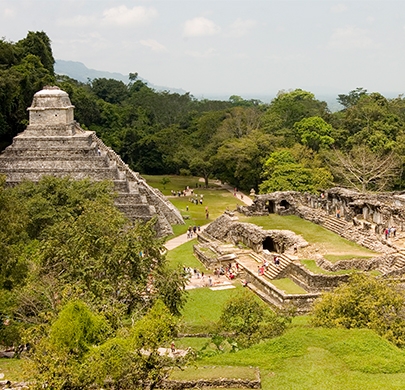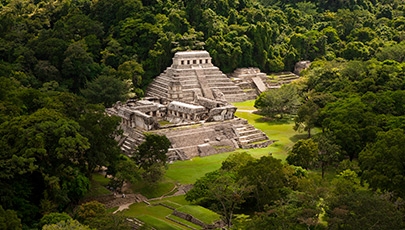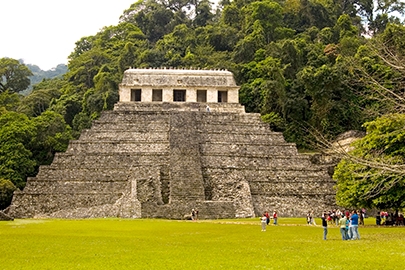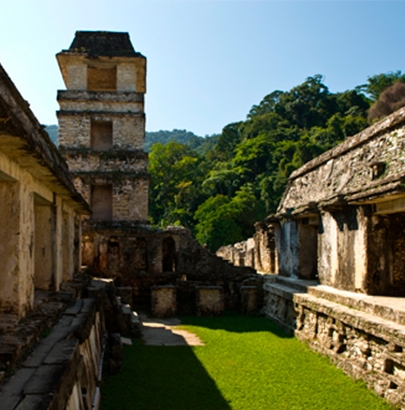
Cultural Patrimony of Humanity.
In the middle of the jungle, Palenque developed as one of the most remarkable cities of the classic Mayan period, seat of a powerful dynasty that dominated the mountains of northern Chiapas and the plains of Tabasco, territory that some researchers have now considered as the kingdom of Lakamhá. Recognized for its innovative artistic style and the high quality of its architectural and sculptural works, the site reached its splendor between the years 600 and 90 of our era.
The tour in Palenque should begin at the Site Museum that displays a collection composed of objects found during the different exploration seasons, among them are the characteristic Palenque clay cylinders that served as pedestals for incense burners, carved stone panels, stucco and glyphs. In front of the museum there is a path that goes up the mountain and crosses a jungle landscape adorned by the Otolum stream and its waterfalls. Groups of buildings, such as Los Murciélagos, sit on this path that leads to the Gran Plaza. In this place is the ball court, the north group and the Temple of the Count. This last building was constructed during the government of Pakal, it consists of five staggered bodies and a temple in the superior part.
The majesty of the Temple of the Inscriptions dominates the Great Plaza. This building receives its name from the glyphic tablets carved in limestone that are in its interior. It is an authentic mausoleum ordered to be erected by Pakal to serve as his tomb. Its famous crypt was accessed by a hidden stairway until 1952, when the tomb was discovered by Ruz Lhuille.
The majesty of the Temple of the Inscriptions dominates the Great Square. This building receives its name because of the glyphic tablets carved in limestone found inside.
It is an authentic mausoleum ordered to be raised by Pakal so that it served him as a tomb. Its famous crypt was accessed by a hidden stairway until 1952, when the tomb was discovered by Ruz Lhuiller.
The burial chamber shows a monumental sarcophagus covered with a tombstone, both decorated with bas-reliefs like the walls of the crypt. The scene of the tombstone presents Pakal between the Monster of the Earth and the cross that symbolizes the cosmic tree on which the celestial bird rests.
Next to the Temple of the Inscriptions there is a platform on which buildings XII and XIII were erected; the latter is also called Temple of the Red Queen, due to the recent discovery of a tomb with the remains of a woman covered with cinnabar and accompanied by offerings.
The Otolum stream, partially covered by the construction called El Acueducto, separates the central plaza from the Conjunto de la Cruz, whose construction has been attributed to Chan-Bahlum, formed by the temples of the Sun, the Cross, the Foliated Cross and XIV. The Temple of the Cross sits on an imposing stepped base. It no longer maintains its façade, but its crest. In the interior of Temple XIV there are panels with characters and inscriptions.
The Temple of the Sun is the best preserved, since it maintains its cresting and much of its impressive stucco decoration. In its interior there is a board and its central attraction is a solar mask.
The Temple of the Foliated Cross also lost its façade, but retains the inner sanctuary, where you can see the panel with the foliated cross representing the corn plant as the axis of the world in the symbolism of cultivated nature. In the Palencia temples it is common to find sanctuaries in the form of small interior temples.
On the banks of the Otolum, inside the jungle are the remains of the Temple of the Beautiful Relief. The XIX and XX temples are also found inside the jungle.
The censers are a summary of the aesthetic quality achieved by the Palenca artists, in conjunction with the exuberance of the landscape, many of these censers have been found in the area of Las Cruces. These objects were of great importance in the rituals because through them the blood of the sacrifice was offered, which was burned together with the copal. They were the vehicle of communication between the rulers and the deities of the sky and the underworld.
How to get:
From Tuxtla Gutierrez, take the federal toll road 190 towards San Cristobal de Las Casas until the Rancho Nuevo junction, and from this point take the federal free road 199 passing through Ocosingo; until you reach the city of Palenque with a total distance of 259 km. From this point take a 7 km detour (road to the ruins) that leads to the archeological zone of the same name.
Schedule
Monday to Sunday from 08:00 to 17:00.
Cost
$ 80.00 MXN per person and $ 37.00 MXN for CONANP (The National Commission of Protected Natural Areas)
For your convenience:
-
It has an on-site museum.
-
Service Unit with stores
-
Chiapas Brand Store
-
Library
-
Audience
-
Children's Workshops
-
Guided tours for school groups
-
Toilets
-
Restrooms at the ticket office and inside the premises.
Activities:
- Recorrido en Museo de Sitio.
Recommendations:
The (National Institute of Anthropology and History) INAH recommends not leaving the trails, respecting areas not open to the public, informative and restrictive signs, as well as visiting the site with comfortable shoes, preferably tennis shoes.








